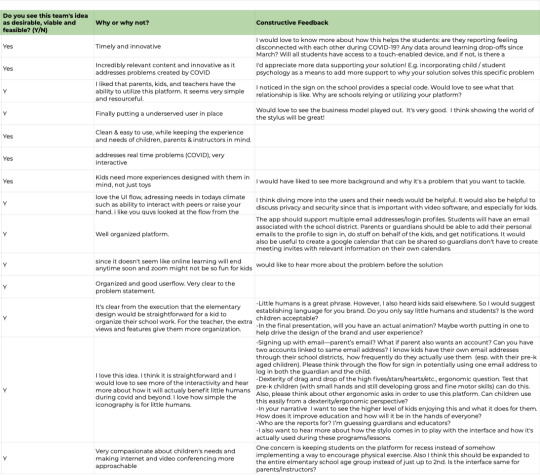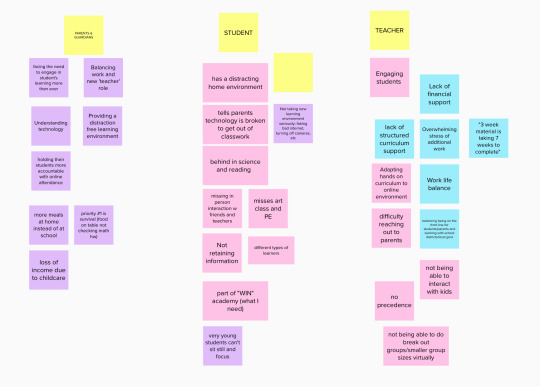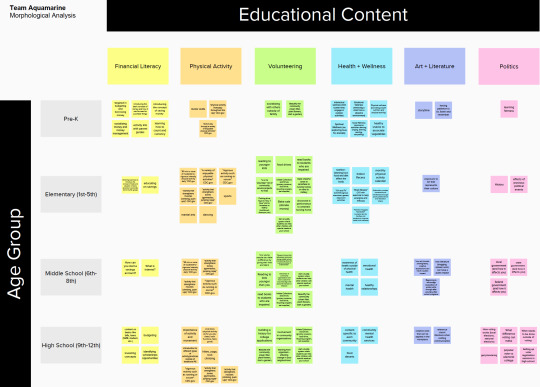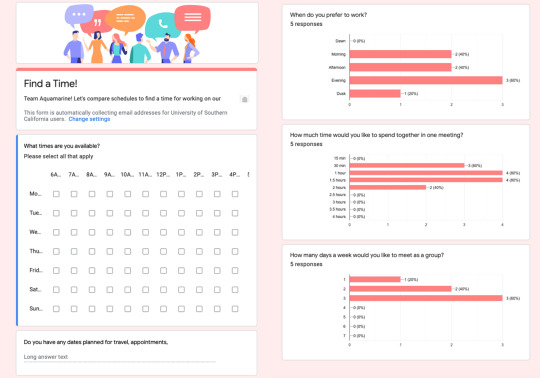Iovine & Young Academy, USC | Processes + Perspectives
Don't wanna be here? Send us removal request.
Photo

Evaluation!
Throughout the seven stages of the creative problem-solving process, Team Aquamarine worked collaboratively to identify weekly objectives, delegate accomplishable tasks, and regularly communicate our design progress noting points of constructive criticism and successful accomplishments. After presenting our Implementation phase of Kideo, showcasing the user experience, product design, and business model, we regrouped to analyze our classmates’ feedback to compare their responses with our intentions. Noting the high interest in Kideo’s playground, we sought out to further develop the feature to emphasize the educational, social, and emotional benefits within our final presentation. Additionally, we determined the need for our presentation deck to be initiated. Breaking down our weekly tasks, we split off to complete the UX/UI design iterations and presentation deck.
Of the methods and techniques reviewed, I find that team Aquamarine has consistently optimized feedback from our classmates, or Jury of Peers, as we remain conscious of our diversity in careers and backgrounds. Consequently, I find that the consistent exchange of feedback has fostered my personal ability to provide constructive criticism to other teams, my team, and myself in my personal work. In reflecting on the tools we used in class to communicate criticism, I found that the Google Sheets format worked best to efficiently and effectively provide and collect feedback. As opposed to the chat offered in Zoom, I could write, reflect, iterate, and repeat without dividing or incorrectly addressing my thoughts. Additionally, the spreadsheet format encouraged me to write more, diversified feedback, and saved time by pre-collecting team notes.
Through reflecting how I can achieve my Personal Best, I find the weekly journals to be extremely insightful for tracking individual and group productivity. Looking back at my posts, I can refer to moments of strengths, weakness, pivots, and opportunities that can further reform our current project or frame a future endeavor. I can also look back at specific tools, methods and techniques that resonated to my group, elevated the overall experience, and fostered professional growth. Looking forward, I plan to maintain this practice - although I ponder other platforms that could replace Tumblr to help elicit a feeling of personal reward.
0 notes
Photo

Continuing Implementation!
Team Aquamarine channeled extreme productivity while working this week, chugging away at our prototype development while collaborating to ensure our solution reflected the needs of the users identified in the analysis phase. Utilizing the data collected in prior research, regarding kid-friendly graphics, user experiences, and user interface designs, we decided to fill in the gaps regarding features and educational additions educators would find valuable to the product.
The team conducted an additional interview with Angela Adams, experienced kindergarten teacher in the Hawthorne school district, where we generated notes on the digital learning curve, currently utilized programs, daily academic routines, and observations on students and guardians during virtual education. After digesting and consolidating her feedback, we highlighted main takeaways including: the mutual concern for students’ emotional wellbeing; educators’ desire for engagement with students through a variety of classwork and flexible activities; and the educators’ need to be able to organize, prepare, and communicate for classes.
Adobe XD became a very close friend of ours as Team Aquamarine further iterated our wireframes and elaborated on our design decisions. Diving into the on-boarding and profiles for students, guardians, and educators, we created a plethora of screens, sequentially ordered and preliminarily filled with pertinent and desired information, materials, and activities. We pivoted from subtle design decisions, including the change of circular camera frames to rounded, rectangular frames for increased visual access and optimization of the interface layout.
Keeping up with our complementary product – the Kideo stylus – we met with Tucker and Jacob over a Zoom call to discuss our project objectives and possible steps for transitioning our two-dimensional model into a testable, three-dimensional prototype. Our feedback included having a manageable design for 3D printing with the distribution of font files, dimensions, and design decisions, as well as advice to reach out to Trent for the electronical components highlighted in our design features, such as light and vibration feedback. While we await our conversation with Trent, we confirmed our direction to develop a physical product to demonstrate and test, at minimum, the ergonomic usability, and ideally the additional sensory feedback features’ usability.
We are very eager to hear the class’s feedback on our progress and hope to gain clarity on Team Aquamarine’s current strengths, points of unclarity, and future steps for Kideo!
2 notes
·
View notes
Photo

Transitioning from Selection to Implementation!
Team Aquamarine ignited the implementation phase by distinguishing our overarching mission to increase remote student engagement, pre-k to 2nd grade, by building a child-centric video conferencing solution for education. Uniting on the decision to create both a digital environment and physical product, we jumped back into Mural to determine next steps and examine the user interaction. We pinpointed three buckets – software features, stylus features, and UX – to categorize key components and attributes necessary to the viability, defeasibility, and feasibility of our solution. To address the variety of our solution’s audience, we broke down the categorizes by user group and generated user journeys to exemplify the student, educator, and guardian perspectives, noting the different steps in their processes.
Having complied our necessary and desired outcomes, we looked towards additional research that would support and further inform our design development and business structure. As a team, we identified ownership over specific components of our weekly objectives– utilizing our professional and academic backgrounds to strengthen and elevate our solution.
Team Aquamarine is elated to present and receive feedback on our creation – Kiddeo!
Kiddeo is the first of its kind digital classroom specifically made to improve engagement of Pre-k through Second grade students in the remote learning environment. The technology includes a library of preset games and activities that encourage social interaction between children, hardware add-on products that capture the attention of disengaged students, and built in mindfulness practices and exercises. Kiddeo intends to support the development of our Pre-k through Second grade children by focusing on the development of the whole child.
Kiddeo’s mission is to increase remote student engagement with their kid friendly, and kid focused, digital classroom. The company is focusing on the entire digital experience for students in order to build an environment that kids want to be in. This environment includes a simplified, and fun, video conferencing interface as well as a stylus that facilities interactions with blinking lights and vibrations. Both pieces of Kiddeo’s product offering are customizable in. order to cater to the individual learner.
Press Release, 2020
0 notes
Photo

Ideation!
Team Aquamarine kickstarted our ideation process by emphasizing our newly refined problem statement we devised at the end of the prior class: How might we support primary education during the transition to remote learning? The problem we’ve identified as a team is a lack of support, reduced engagement, and improper usage of technology. Noting our timely completion of the following week’s course work, we jump started our team deliverables by outlining our methodologies and noting the reviewed brainstorming techniques.
As individuals, we dived into our ideation process by brainstorming ideas centered around our idea generation question: [How may we] increase support, improve engagement, and encourage proper usage of technology? Referencing the user pain points our team arranged to devise our problem statement, I used Miro to create an independent brainstorming document where I generated ideas that tackled solving the various facets of the problem. A mildly flexible time cap was set for this stage of the process to heighten productivity, efficiency, and what – I felt to be – exhilaration. To maintain consciousness and consistent visibility of the problem throughout ideation, I highlighted the team’s statement on each medium utilized. While my independent brainstorming session induced a multi-dimensional environment, actively working between my computer, sketchbook, and whiteboard, I noted the shift to a primarily digital workspace when regrouping with the team.
To initiate the first part of our collaborative ideation process, we divided the team into two groups using Zoom’s breakout rooms. As my “mini-group” shared each of our individual work, we discussed our similarities, differences, and favorites amongst ideas while conversing possible iterations and merging opportunities. Maintaining mindfulness of time management and high-yielding benefits, we planned to regroup as a whole in approximately half an hour.
Balancing the array of opportunities with overload management, incentivized the decision to narrow in on the top three ideas created among the breakout group. When rejoined with the others, we followed a similar process of analyzing each of the top ideas’ strengths, weaknesses, team interest, and – most importantly – relevance to the problem statement. After outlining each idea with a general title and accompanying description, we voted on our top three ideas by tagging our initials to each idea and bolding those we favorited.
After some time away, we reevaluated and modified our ideas to diversify solution strategies and faithfully address the problem statement. Rejuvenated and restored, Team Aquamarine reached a consensus, solidifying our top three ideas:
The Virtual Think-Tank: A social platform for the educational community to exchange successful and unsuccessful tactics and techniques.
Learning Boxes: Weekly kits that deliver various subject materials and lessons to students.
Kid’s IoT Device: An interactive product for children to promote physical activity and support mental health.
0 notes
Photo

Team Problem Defining!
In comparing each of our individual problem statements, we found that a main commonality was to focus on the strains that remote education has forced onto schools and families. While each of our statements identified a target audience, some chose to narrow down on a subset of users and their given issues, while others found connections between different groups and made associations between their challenges.
To effectively organize our thoughts on the community of users affected by remote learning, we jumped back onto Mural where we splattered the board with notes on specific pain points. In sorting and grouping the notes, we titled three buckets of categorized challenges: (1) lack of support (2) lack of engagement (3) technology related. Furthering our data analysis, we looked into creating three personas that would synthesize our research into a handful of chosen users – guardians, students, and teachers.
Steering towards our specified users and challenges, we manipulated sentence structures and terminology to create our team’s problem definition. We wanted to ensure that our core insights and takeaways were clearly embedded. Team Aquamarine concluded with:
The shift to remote learning in primary education has forced teachers to modify their curriculum, guardians to assume a role of increased involvement, and students to adapt to an at-home learning environment. This pivot has unraveled challenges including a lack of support, reduced engagement, and improper usage of technology.
0 notes
Photo

Problem Defining!
As our team interviewed Margarita G., elementary school principal in East Los Angeles, we accumulated insights into the specific pain points that effect various user groups with the transition to remote learning. While the initial note-taking process embodied a free-form, anything-goes, write-it out technique, I later individually distilled the information by highlighting key words and boiling down the components into a personal list of key takeaways. I noted two main buckets of takeaways: major challenges and endeavored solutions. In regards to challenges, Margarita emphasized five prevalent concerns: (1) familial economic and social-emotional issues (2) lack of academic accountability by students and guardians (3) difficulty engaging pre-k, kindergarten, and 1st graders via digital platforms (4) distracting home environments (5) less adaptable content learning for subjects including science, fine art, reading and language arts, and physical education. The solutions she referenced included (1) “learning bags” filled with educational materials delivered to students for remote hands-on learning and engagement (2) “interventions” that provide small group instruction top target specified needs of the students (3) “parent workshops” that build bonds, educate, and engage students’ guardians (4) “Chromebooks” supplied to each student for access to their curriculum content. With this information synthesized, I generated my problem statement:
Educating the future of our communities will promote economic growth, motivate initiative, and inspire success. With the shift to remote learning, the relationship, or bond, between school and home has unveiled itself as an essential component for success in our youth’s educational development. Children and parents are found to be less accountable towards completing academic work, distracted by their home environments, and burdened by economic and social-emotional issues. There is prominent difficulty with engaging students across pre-k, kindergarten, and first grade utilizing virtual learning platforms, specifically for the subject areas of science, fine arts, language arts, and physical education.
0 notes
Photo

Analysis!
In a way, I feel that as individuals our team worked as collectors, gathering information we deemed necessary or relevant to our own understanding of the problem, keeping fairly organized with immediately relevant material. However, as our Google Drive document added layer upon layer, I found that as a whole we were collecting various references and facts that targeted unique angles related to our topic on childhood education.
This insight led to the team to converse about the scope of the project, including the array of user age groups and opportunity for educational content. We utilized attribute listing, creating a list of general categories (age ; educational content) and breaking down specifics within those categories (pre-k, grade school, middle school, high school ; financial, physical, volunteering, health, arts, politics).
To further organize our thoughts and dive into brainstorming, we initiated work on our morphological chart utilizing Google Sheets to place our categories across 4 rows and 6 columns. Collectively, the team wrote in ideas, thoughts, references, and facts specific to the category intersection. To provide a more flexible and visually stimulating workspace, I transferred the team’s information to Mural, utilizing the digital platform’s Post-it’s to color coordinate, organize, and leave room for additional findings. A key takeaway I had from this experience is that by utilizing Mural over an Excel format, more than one team member could work on an overlapping subject matter, without the worry of deleting or editing the other’s information by accident!
1 note
·
View note
Photo

Acceptance!
With the pandemic providing both challenges and opportunities for the US education system, our team decided to unite our passions to focus on improving the quality and scope of virtual education to America’s youth. As we divulged into our subject matter, becoming more aware of the latitude of problems and challenges, we accepted the problem areas of supplemental content, delivery of education, access to resources traditionally provided by school directs, and opportunities for virtual community engagement.
To generate self-motivation for this project, the team meet and thoroughly discussed each of our educational backgrounds, occupational skills, and passionate interests. The conversations initiated as a general user group was prompted - children. This ignited discussion into education systems, which led to further investigation into the topic and provided points for individualized research we would bring together for the next meeting.
With a team of five, assuming responsibility and committing to the problem is vital to successful collaboration and project delivery. Laying a foundation for collaborative time, I created, distributed, and gathered scheduling information to identify our reoccurring meetings, conflicts, and work preferences. Some of the key takeaways I have from this experience are asking the team “how much time would you like to spend together in one meeting?” and “How many day a week would you like to meet as a group?” These responses provided a pivot from our initial scheduling plan to allocate additional time throughout the week dedicated to Team Aquamarine!
1 note
·
View note
Photo

Kindling Creativity!
What does creativity look like to me?
While I do view creativity to be an intimate experience in some cases, I find that as we collaborate with others and exchange our creative processes, the collection of our thoughts and ideas can heighten the creative experience beyond being confident in your own work. I passionately agree that everyone is intrinsically creative and that each of us contribute to problem-solving whether it be by identifying problems through observation or ideating solutions to the issues.
What makes creativity flourish?
Through my studies in environmental psychology, I have become far more aware of my surroundings and how the space I place myself into affects my health and wellbeing, concentration and efficiency, and ability to spark inspiration and creativity. Plants, views of nature, natural light, or even natural aromas are some of the features that help me spark creativity. Interestingly enough, technology such as my cell phone and computer tend to interrupt my mind from exploring endless possibilities and controls my thought process instead.
How would I define inspiration?
I agree that inspiration comes from both a subconscious and conscious level, pinpointing both current and past events that are uniquely relevant to our lives. I find that looking back into my childhood is a great source for inspiration as it allows me to identify the places, products, people, and situations that excited me the most and shaped who I am today. Identifying these passionate moments in my life has helped nurture my interest areas as a designer and entrepreneur.
A hack in my daily life:
One of the hacks I have employed though shifting to remote work is utilizing a decorative hair clip to organize access my electrical cords for my laptop, headphones, and iPad. While the product was intended to act as a hair accessory, I find it reflects our ability as creative individuals and adds a fashionable touch to my workspace.
0 notes
Text
Creativity
To me, creativity is using imagination, passion, and ambition in pursuing untouched problems or overlooked opportunities by manipulating materials, learning techniques, and gaining perspectives to ideate and produce innovative solutions.
As a child, I practiced creativity by collecting mediums, arranging objects, altering characteristics, and finalizing compositions that would respond to the array of concepts and ideas spinning through my mind. I continued to follow my journey as a creative individual and have found that each endeavor has impacted the way in which I assess my own creativity.
With incredible opportunities for developing design thinking techniques, learning career-specific computer programs, and ideating with collaborative groups and partnerships, I have learned that practice is key to consistent improvement. One of the ways in which I spark creativity in my daily life is by keeping a pen and journal with me at nearly all times. By doing this, I have been able to organize my thoughts through brief notes and sketches that enhance my brainstorming and ideation skills.
In becoming more aware of my surroundings and the impact my environment has on my creative output, I have provided myself with a general guide to adjust my space to suit my work life. Ample lighting, natural elements, and memorable imagery are key components that provide me with balance between stimulation, restoration, and reflection. This balance has been vital to setting a creative atmosphere for myself, and a resourceful ally in my work ethic.
An important aspect of creativity I have learned to accept is viewing failure as a point of progression. One of the greatest aspects of creativity is allowing yourself to think of all the possibilities available for solving a problem, especially those that are unconventional. However, it has been vital to my career as a student and professional to associate trial and error with opportunities for growth and to always keep a positive outlook throughout each venture.
1 note
·
View note